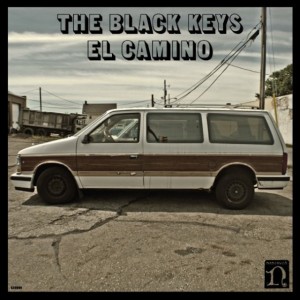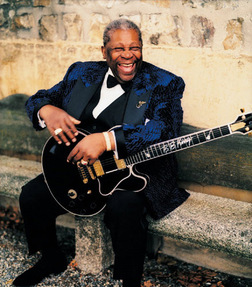Blues Rock in The Studio: The Perpetual Sound — The Black Keys to Jimi Hendrix & B.B. King
As The Black Keys entered the stage of The 55th GRAMMY Awards recently, albeit with much GRAMMY flare that included a horn section and bass drummer, it’s interesting to think, “Has blues rock’s sound evolved that much, if at all? Has blues rock’s popularity once again reached a peak?”
Famed musician Eric Clapton once said, “I am, and will always be, a blues guitarist,” and the same seems to hold true for most artists in the genre, both old and new.
Rock’s Roots in the 12-Bar Blues
Since the mid-1960s when the genre emerged from Britain and the United States, blues rock had a way in both style and sound that spoke to the soul. In recent years, the production value, technique, and composition have remained unchanged. In addition to The Black Keys, current artists like Jack White, Gary Clark Jr., and even John Mayer remain faithful to the twelve-bar blues style of writing, with wailing improvisations courtesy of the pentatonic scale that was introduced so many years ago.
Some of the earliest bands to the genre included The Rolling Stones, Jimi Hendrix, The Doors and The Animals, who took largely from classic blues artists like B.B. King, Muddy Waters, and Jimmy Reed. Hendrix took the world by storm and his timeless talent is still celebrated today, with specific attention given to the forthcoming release of a new album titled People Hell and Angels, which consists of previously unreleased material from the artist.
John Mayall and Fleetwood Mac were also major players in the formation and survival of the genre. The electric sound of blues rock and it’s faster and louder qualities is what separates it from the various types of blues. Producers like Britain’s Mike Vernon, known for his involvement in early and now current blues rock production, were critical in the focus of that naked, live sound that listeners love to hear. The engineer/producer relationship and particularly their love for this style of music has also continued to be extremely important. This factor is crucial in terms of quality and the reason why many great records have hit the shelves.
Hear evolution in action via “Lonely Boys” off of The Black Keys’ El Camino.
Maintaining the Studio Sound
Within the genre, minimal studio work is utilized, a raw sound is encouraged, and the band is, in most cases, recording together in the same room. Most guitarists will use a tube amplifier to secure that rough, overdriven sound that one so often hears from these artists. A piano or Hammond organ is often used to complement the grungy sound and, at times opens up a spot for a new band member. Similarly, a backup guitarist will sometimes tackle the riffs while the lead guitarist will focus on rhythm. However, most blues guitarists are multi-instrumentalists. The popular “call and response” technique, which started to develop in the late 1960s, is often applied by dueling guitarists. Vocals, which often have a southern tone, are often essential, but there are many instances where an instrumental track will suffice.
In the early 1970s, riffs became overwhelmingly popular. At the same time, hard rock began to emerge from blues rock to create the broad category of alternative rock, which was the current trend at that juncture. Blues rock had taken a back seat for the time being, with acts like Led Zeppelin, Jeff Beck and AC/DC (all highly influenced by the evolution of blues rock) getting a bit heavier with their music. This did not stop the dedicated blues players like Eric Clapton and B.B. King, however, who played on.
In the early 1990s, blues rock began its comeback with bands like The Black Crowes and Blues Traveler. Southern Rock, like The Allman Brothers Band, Lynard Skynard, and ZZ Top began to work its way into the category. In the early 2000s Jack White stormed the airwaves with his band The White Stripes, and artists like Joe Bonamassa, Gary Moore and even more recently Them Crooked Vultures started to get people’s attention again. All of these artists were inspired by pioneers of the genre.
With blues rock back in play and now in the spotlight, acts like The Black Keys and Jack White are enjoying fame and platinum selling records, all the while sticking to their original sound. Of course if you have followed their discography you will notice slightly cleaner studio work and as much of a polished sound as you can get for blues rock, but that comes with the territory. The fact that these artists can now reach new audiences and keep the newly revived (but never lost) genre alive is the beauty of the music industry. It had even been reported post-Grammys that both The Black Keys and Jack White showed a leap in record sales.
It is also incredible to see both old and new bands working together, as when The Black Keys joined The Rolling Stones on stage in New Jersey at the final stop of the recently reunited Rolling Stone’s 50th Anniversary Tour. In a January, 2012 Rolling Stone interview, The Black Keys frontman Dan Auerbach proclaimed, “I wasn’t even thinking about songwriting on the early records, just music and the groove. It was absolutely just fucking around –taking old blues riffs, making up lyrics on the spot, and turning it into a song. Then we started sort of digging into these records that we love, and trying to figure out why it is we love them so much, besides the sonics.” It’s amazing to see how far they’ve come just by doing what they love most.
Back — to the Future
Blues rock has shown us that it has and will continue to be a lasting genre, regardless of the ever-changing culture. As such, while working with blues rock artists in the coming years, a more back-to-basics approach should be utilized by both producers and engineers. Studio enhancements are not always necessary. This raw development style has always been the genre’s celebrated finished product.
Listen to some classic blues rock before hitting the studio and emulate the production value to the best of your ability. The influence and potential of blues rock to build timeless music will always be there. It had transformed rock music forever in the 1960s and we still have the future to look forward to.
What direction will The Black Keys take? What new bands will pop up? Regardless, it looks like we’ll be hearing a lot more twelve-bar blues for years to come.
— Michael Haskoor is a freelance music writer with a passion for music. He currently enjoys writing for Live For Live Music and will focus this series (done exclusively for SonicScoop) around the effect that studio production has had on different genres of music.
Please note: When you buy products through links on this page, we may earn an affiliate commission.









pppPerryandtheMETS
March 30, 2013 at 7:25 am (11 years ago)…and for some, like me, blues based rock never left.